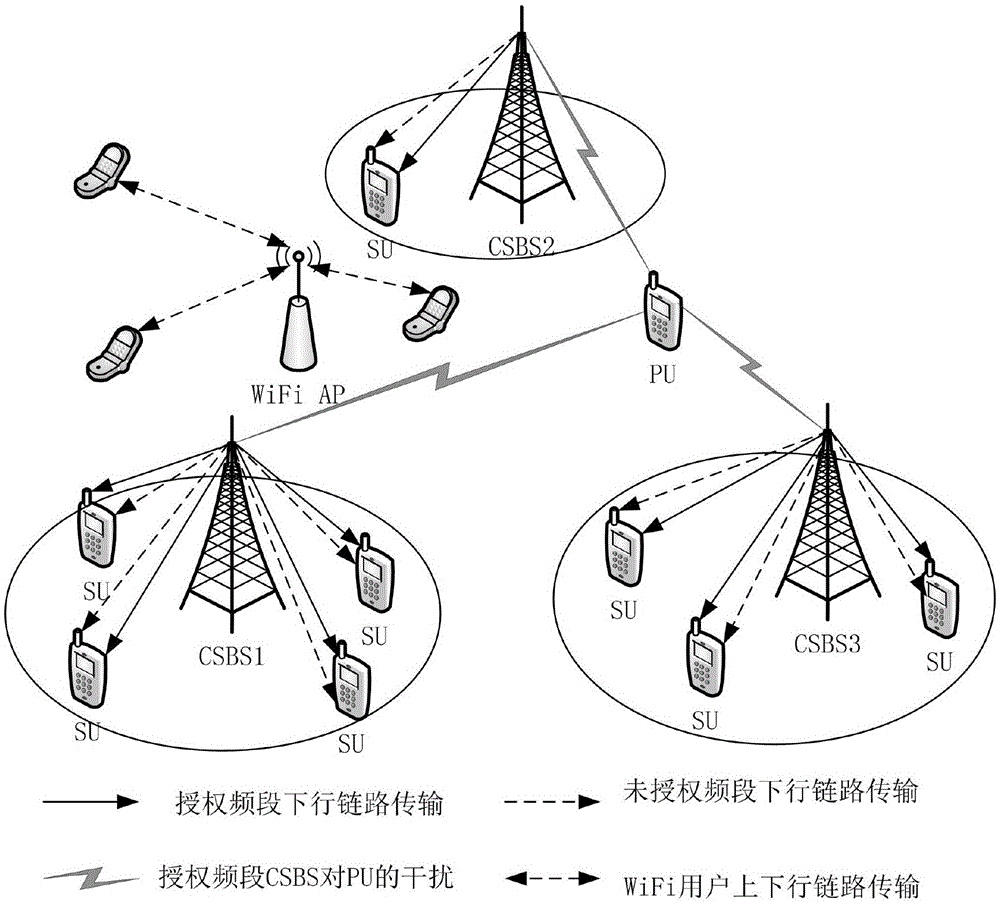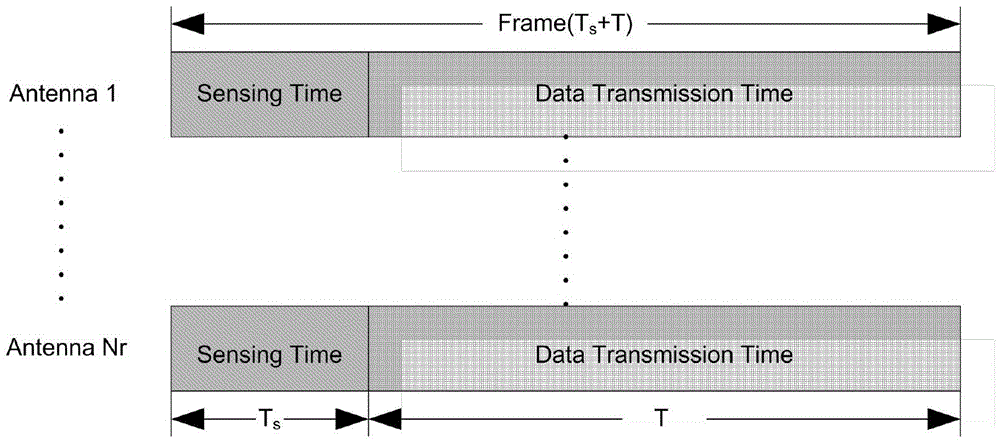Cognitive small-cell dual resource allocation and disturbance management method based on LTE
A resource allocation and interference management technology, applied in the field of resource allocation, can solve the problems of low transmission power of small cells, small coverage, and increased network capacity
- Summary
- Abstract
- Description
- Claims
- Application Information
AI Technical Summary
Problems solved by technology
Method used
Image
Examples
Embodiment Construction
[0035] 认知小蜂窝在使用自身授权频段的同时可以检测并使用其他的授权和非授权频段上的空闲资源。由于其自身授权频段所产生的传输速率是一定的,本发明中不考虑认知小蜂窝使用自身频段所产生的通信速率。认知小蜂窝用户即认知用户,在授权频段上与授权用户共享频谱,为保护授权用户的通信质量不受认知用户影响,在未授权频段上认知用户与WiFi用户竞争使用频谱,为提高未授权频段的频谱利用率,针对认知用户与WiFi用户共存提出一种简单有效的干扰管理和信道接入方案。认知小蜂窝的双重资源分配和干扰管理方法充分利用了授权和未授权频段资源,最大化整个网络的传输速率,提高用户满意度和系统性能。认知小蜂窝能够同时使用授权和非授权两种频段,且通过LTE载波聚合将两个或者更多的授权或非授权载波聚合在一起以支持更大的传输带宽,提高上下行传输速率。在授权频段,认知用户伺机接入授权频段,当授权用户的干扰低于门限值时,认知用户与授权用户共享频谱,同时动态选择最佳的认知小蜂窝基站进行数据传输;在未授权频段,认知用户与WiFi用户竞争使用未授权频段。
[0036] 但由于各种无线设备之间缺乏相互干扰的协调和管理,尽管大多数技术在设计时能够处理同种类系统之间的干扰,但认知小蜂窝和WiFi用户分别属于不同系统具有不同的时隙调度模式,因此他们之间的干扰处理存在一定困难,他们的共存问题将是一个极大的挑战。在未授权频段上,WiFi设备已经部署十分广泛,为了保证WiFi用户性能不受影响,需要一个新的资源分配方案使得认知小蜂窝和WiFi用户在未授权频段协调共存。
[0037] 认知用户采用频谱检测的动态接入方式使用授权频段,即认知小蜂窝基站基于能量检测获取授权用户的状态信息,若能量检测值低于检测门限,判定为授权用户未使用频段,则认知用户动态地接入授权频段传输数据,当认知用户检测到授权用户再次出现时能够及时退出正在使用的授权频段。认知用户和授权用户共享使用授权频段,提高频谱利用率,同时动态选择最适合通信的认知小蜂窝基站,提高整个网络的性能。
[0038] 认知用户和WiFi用户竞争使用未授权频段。认知用户在使用未授权频段传输信息之前每隔一个时长T 0 就检测一次信道,判断是否有用户在使用信道,若信道繁忙,即有WiFi用户在使用信道,则认知用户等待一个的时长T 0 后再次进行检测,若信道空闲,则认知...
PUM
 Login to View More
Login to View More Abstract
Description
Claims
Application Information
 Login to View More
Login to View More - R&D
- Intellectual Property
- Life Sciences
- Materials
- Tech Scout
- Unparalleled Data Quality
- Higher Quality Content
- 60% Fewer Hallucinations
Browse by: Latest US Patents, China's latest patents, Technical Efficacy Thesaurus, Application Domain, Technology Topic, Popular Technical Reports.
© 2025 PatSnap. All rights reserved.Legal|Privacy policy|Modern Slavery Act Transparency Statement|Sitemap|About US| Contact US: help@patsnap.com



